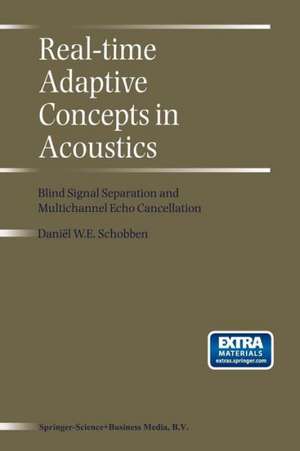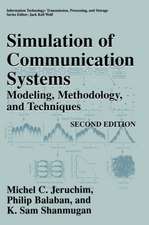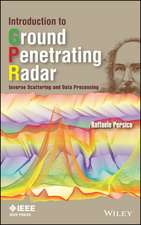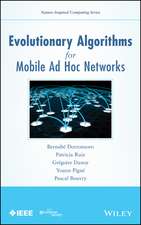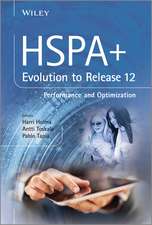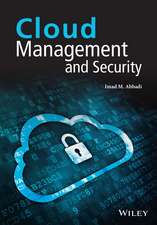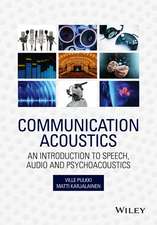Real-Time Adaptive Concepts in Acoustics: Blind Signal Separation and Multichannel Echo Cancellation
Autor D.E. Schobbenen Limba Engleză Paperback – 2 noi 2012
Acoustic Echo Cancellation (AEC) is a well-known technique to suppress the echo that a microphone picks up from a loudspeaker in the same room. Such acoustic feedback occurs for example in hands-free telephony and can lead to a perceived loud tone. For an application such as a voice-controlled television, a stereo AEC is required to suppress the contribution of the stereo loudspeaker setup. A generalized AEC is presented that is suited for multi-channel operation.
New algorithms for Blind Signal Separation and multi-channel Acoustic Echo Cancellation are presented. A background is given in array signal processing methods, adaptive filter theory, and fast filtering in the frequency domain.
The included CD-ROM can be played using any compact disc player to play the simulation results that are described in the text. When inserted into a computer, it furthermore gives Matlab implementations of the new algorithms along with audio data with which to experiment. This makes the book suited to researchers, engineers, and university students, who want to get acquainted with these emerging fields.
| Toate formatele și edițiile | Preț | Express |
|---|---|---|
| Paperback (1) | 634.49 lei 6-8 săpt. | |
| SPRINGER NETHERLANDS – 2 noi 2012 | 634.49 lei 6-8 săpt. | |
| Hardback (1) | 640.55 lei 6-8 săpt. | |
| SPRINGER NETHERLANDS – 31 iul 2001 | 640.55 lei 6-8 săpt. |
Preț: 634.49 lei
Preț vechi: 746.47 lei
-15% Nou
Puncte Express: 952
Preț estimativ în valută:
121.42€ • 125.100$ • 101.49£
121.42€ • 125.100$ • 101.49£
Carte tipărită la comandă
Livrare economică 15-29 martie
Preluare comenzi: 021 569.72.76
Specificații
ISBN-13: 9789401038577
ISBN-10: 9401038570
Pagini: 176
Ilustrații: XII, 160 p. 1 illus.
Dimensiuni: 160 x 240 x 9 mm
Greutate: 0.25 kg
Ediția:Softcover reprint of the original 1st ed. 2001
Editura: SPRINGER NETHERLANDS
Colecția Springer
Locul publicării:Dordrecht, Netherlands
ISBN-10: 9401038570
Pagini: 176
Ilustrații: XII, 160 p. 1 illus.
Dimensiuni: 160 x 240 x 9 mm
Greutate: 0.25 kg
Ediția:Softcover reprint of the original 1st ed. 2001
Editura: SPRINGER NETHERLANDS
Colecția Springer
Locul publicării:Dordrecht, Netherlands
Public țintă
ResearchCuprins
Background and Introduction.- 1. Introduction.- 2. Array Processing Techniques.- 3. Efficient Filtering Using FFTS.- Acoustic Echo Cancellation.- 4. An Efficient Adaptive Filter Implementation.- 5. Efficient Multichannel RLS.- Blind Signal Separation.- 6. Blind Signal Separation, An Overview.- 7. A Blind Signal Separation Algorithm.- 8. Joint Blind Signal Separation And Echo Cancellation.- 9. Blind Signal Separation Algorithm Evaluation.- 10. Conclusions.- Appendices.- A. Efficient Beamforming.- A.1 Introduction.- A.2 Linear Sensor Array Beamforming.- A.3 Interpolation Beamforming.- A.4 Polyphase Decomposition.- A.5 Comparison of Computational Complexity.- A.6 Example of Computational Complexity.- A.7 Conclusions.- B. Indeterminacies of Convolutive BSS based on Decorrelation.- B.1 Convolutive BSS Indeterminacies.- B.2 Rank of the Source Correlation Matrix.- B.3 Real World Data Considerations.- C. Computational Complexity of CoBliSS.- C.1 Fast Fourier Transforms.- C.2 Correlation Update.- C.3 Weight Update.- C.4 Filtering.- C.5 Normalization.- D. Efficient computation of windowed FFTs.- D.1 Efficient Computation of Windowed (I) FFTs.- D.2 Efficient Recursive FFTS of Overlapping Data.- of the Compact Disc.- References.
Recenzii
'This book is clearly written and well organized. The author has spent considerable effort to present material in a clear and concise manner. This can be recommended for readers who are interested in a quick overview of basic concepts and acoustic application of blind signal separation and echo cancellation, and for the readers who are familiar with these applications, but who want to understand and use new algorithms that have been presented in the book.'
The Journal of the Acoustical Society of America, August (2002)
The Journal of the Acoustical Society of America, August (2002)
